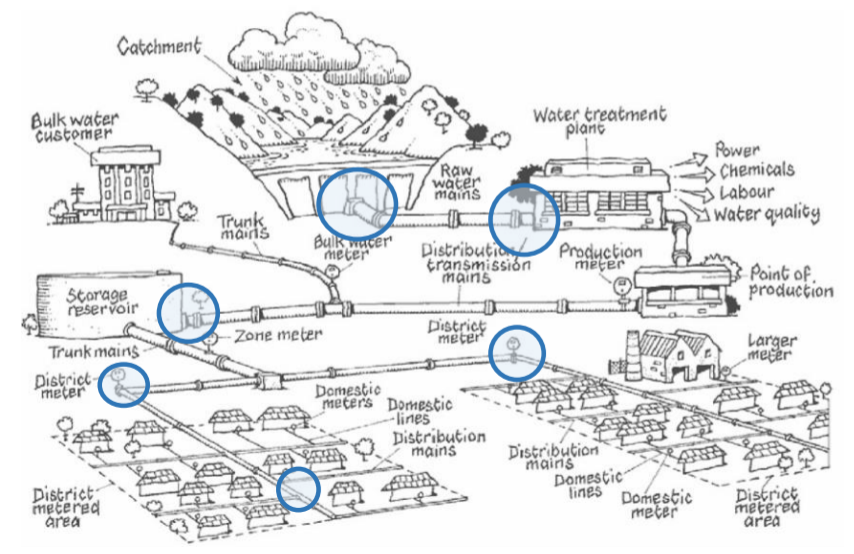
Investigating the non-technical challenges to installing micro-hydro in water networks
Posted on: June 2019Dawn Murphy, Action Renewables
Investigating the non-technical challenges to installing micro-hydro in water networks.
| About the author: Dawn Murphy is a Senior Project Manager for Action Renewables. Action Renewables is a registered charity that aims to create a Northern Ireland which recognises the serious impacts of climate change, and will take measures to prevent and mitigate against those impacts, through using renewable energy, energy efficiency, renewable transport and renewable products. |
 |
|
What are we trying to achieve?
To develop an adequate institutional, social and technological environment to foster greater resource efficiency in water networks through the installation of innovative micro-hydropower (MHP) technology.
What is hydropower energy recovery in a built water network?
There are parts of all water pipe networks where there is an excess head or pressure and subsequently there are a range of locations within the water distribution network where infrastructure such as pressure reducing valves (PRVs) and break pressure tanks (BPTs) are installed to manage the downstream pressure and prevent pipes from weakness and leakage or bursting. This dissipated energy can, however be recovered by using micro-hydropower technologies. There are lots of opportunities for the installation of this technology as shown in the diagram below showing a typical water supply system.

Fig.1: Queensland Environmental Protection Agency and Wide Bay Water Corporation (2004). Managing and Reducing Losses from Water Distribution Systems: A series of 10 manuals.
One type of micro-hydropower system is a pump working as a turbine (PAT). These PATs can be installed in bypass with the existing pressure valves working together with them, with the added benefit of generating electricity by exploiting the hydraulic energy potential.
Has it been done before?
The concept of running a centrifugal pump in reverse rotation mode has been around for some time and has been exploited but only to a limited extent to generate power usually in areas where a traditional turbine would be too expensive. Traditionally locations with a low energy potential in water distribution networks (where pressure reducing valves are installed) were not exploited for power generation as the water and electric companies were focused on large scale hydro power plants equipped with traditional turbines. However this is changing and these small installations have become more interesting and viable due to the following factors:
- Increased energy prices – energy prices have risen significantly so the payback period for these small projects has been reduced significantly too especially in installations where the energy is used for self-consumption.
- Technical improvements - manufacturers have made PATs more efficient and reliable for installation in water distribution networks, for example, using variable speed drives.
- Lower environmental impact – There is a multitude of points in the water distribution network where PATs can be installed without causing any environmental impact. This is in contrast to traditional hydro plants located in rivers.
- Reducing carbon emissions - PATs are a very good opportunity for water network operators to reduce their carbon footprint, which is a key requirement in most water companies environmental / climate change commitments.
So the technology is now in its expansion phase, mainly in Europe and the United States, where the main PAT manufacturers are located. The implementation of PATS is low at the moment with the water companies installing them as ‘innovation’ projects focussing in locations where the highest energy potential is and where the energy can be consumed on site. To arrive at a more widespread implementation, manufacturers still have work to do to demonstrate that the integration of PATs into water networks is safe and does not affect their operation.
Why is it important?
Reducing energy use in the water industry is a high priority – the supply of treated water and managing waste water are energy intensive processes and with continuing population growth, household water demand is increasing. The water industry is one of the most energy intensive industries in the Atlantic Area and the energy consumption embodied in pressurised water networks represents around 2–3% of global energy consumption (1). Additionally parts of the region have large irrigation needs and as a result of climate change, higher irrigation water demands are predicted. This will obviously require more energy and result in higher CO2 emissions.
What are the challenges?
There are a lot of challenges or barriers to the installation of this technology for example technical challenges - water networks are complex and there are many flow variations in water distribution pipes which reduces turbine efficiency and makes MHP projects less economically viable. Also, even though the conventional larger turbines (Kaplan, Francis etc) cannot usually be scaled down in an economically viable way, the lack of performance curves for the smaller pump-as-turbine technology makes their application more difficult (2).
But what are the non-technical challenges?
There are various non-technical barriers such as lack of financial incentives for this technology in many EU countries, disparate water governance policy at the national level in the AA and lack of awareness of the potential positive social and economic impacts of MHP.
What will REDAWN do?
To address the technical challenges above, REDAWN project partners Trinity College have been completing an energy recovery resource assessment in the water networks. This has involved quantifying the total potential for the MHP technology in water pipe networks in the whole Atlantic area. Our partners in University of Napoli are also developing design guidelines and support tools for hydropower energy recovery in drinking water, waste water, irrigation and process industry sectors. Read about all of the REDAWN work packages here. To date the project partners have produced several technical research documents and presentations in addition to conference proceedings which are available, via the multi-language REDAWN website.
What are the outcomes?
In terms of the non-technical barriers the outcomes of work package 8 (Policy and Social Impact) are as follows:
- Produce a policy support framework manual – this will provide an understanding of how governments could facilitate and encourage the uptake of MHP and respond to barriers associated with water innovation.
- Conduct policy focus groups with policy makers and state agencies to influence inclusion of MHP within water management policies.
- Benchmarking institutional structures – different organisational structures as well as various external incentives and penalties exist across the region. We will highlight areas of good practice – what worked well and what didn’t.
- A policy effects mapping tool - we will assess the positive and negative social, environmental impacts of MHP recovery.
- Assessment of economic factors across the AA – e.g. varying financial incentives, technology costs and economic regulations such as carbon tax. We will establish best practice economic policy measures which will inform stakeholders and encourage a more rapid uptake of MHP. This article focusses on the non-technical aspects of MHP however progress and outcomes of the technical work packages are all available on the project website.
What we found so far?
In terms of policy support research, so far we have conducted several interviews with stakeholders in Ireland such as Regulators in Northern Ireland and Republic of Ireland, NI Water, Group (community) Water Schemes, Consumer Council, Environment agencies and Government departments. From these interviews, a common theme is lack of knowledge about the potential for MHP technology and in particular PAT technology, however there is also a common theme of openness and an appetite for innovation in water energy efficiency to be brought to the table, in both NI and ROI. The Commission for the Regulation of Utilities in Ireland for example has established an innovation fund which is available for Irish Water to apply for in relation to any efficiency projects including energy. This was created to provide a fund specifically for innovative projects which may not have been taken forward if their funding had to come from the normal revenue control process due to the perceived risk. There has been no MHP put forward for this scheme yet; however the Regulator is open to all innovative technologies.
We have also been investigating the governance and administrative structures in each region via the compilation of case studies of existing micro-hydro installations. So far we have gathered information on 7 case studies in Ireland, NI, Wales, Spain and Portugal with France to follow. This allows us to compare the organisational structures across the regions and highlight areas of good practice, for example, where some projects have experienced a streamlined installation process, others have encountered delays due to administrative barriers. Where some installations have benefitted from government financial incentives, some did not proceed due to the same issue.
We also looked at the current perception of MHP in the water industry by gathering survey data from industry professionals and stakeholders at the WATEF (Water Efficiency Network) conference in 2018. As an extension to this we are also currently carrying out questionnaire surveys of community water schemes in Ireland and irrigation associations in Spain.
What we hope to find out?
- We hope to gain an understanding of the different approaches to existing MHP installations in the AA and identify the best practice examples.
- We want to find out if there are any negative social and environmental impacts and how to mitigate against these, whilst promoting the positive social and community impacts.
- Lastly we hope to find out which financial incentives work and which have a positive / negative impact upon the uptake, timescale and process of MHP projects. Subsequently we can use this work to raise awareness of the potential contribution that MHP can make and influence policy makers to provide the right conditions to support it.
Finally…
REDAWN is a three-year project enabled by financial assistance from ERDF funds of the Interreg Atlantic Area programme. The project will complete in Spring 2020.
Find out more about REDAWN
Watch a short film about our work on the REDAWN YouTube channel
Want an overview of the REDAWN project? Watch now
What makes REDAWN unique? Watch now
Read our latest publications here
References
1. Nogueira, M.; Perrella, J. Energy and hydraulic efficiency in conventional water supply systems. Renew. Sustain. Energy Rev. 2014, 30, 701–714
2. Mitrovic et al (2018). Hydropower energy recovery in water pipe networks: spatial regression analysis using GIS, assessing the correlation between energy recovery potential and geographical data. Trinity College Dublin.



